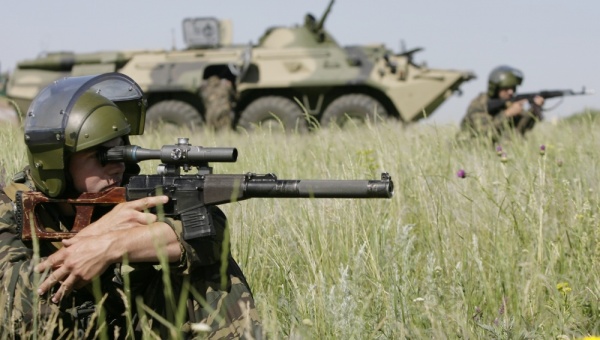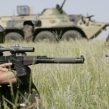
Moscow Plans Rapid Reaction Forces and Professional Soldiers—Again
Publication: Eurasia Daily Monitor Volume: 10 Issue: 46
By:

Moscow’s plans to reform and modernize its conventional Armed Forces have become encased in experiment, indecision, bureaucracy and secrecy. Since Army-General Sergei Shoigu was appointed as the defense minister in November 2012, the “reform” has officially stayed “on course,” while numerous instances of revision or quiet abandonment of many of the Anatoly Serdyukov and Nikolai Makarov–era initiatives ensued. Shoigu couches the aims and agenda of what he terms “capacity building” by referencing the “Defense Plan” to 2016 (Nezavisimoye Voyennoye Obozreniye, March 8). On the surface it may seem that Russian defense planning is now finally linked to a measureable and fixed agenda, yet the plan to which Shoigu refers is entirely secret, thus eliminating any trace of scrutiny of its formulation and implementation.
Nonetheless, two elements of Shoigu’s recent statements on defense planning over the next five years reflect continued uncertainty concerning military manpower and force structure; these are the intention to bolster the lightly armed Airborne Forces and boost overall numbers of serving contract personnel (kontraktniki). Such aims will face the same challenges that slowed and skewed the early 2008 reform agenda (Nezavisimoye Voyennoye Obozreniye, March 1).
On March 6, the chief of the General Staff, Army-General Valeriy Gerasimov, addressed defense attaches in Moscow. Gerasimov stated that the defense ministry now intends to create a Special Operations command. “Having studied the practice of formation, training and the employment of Special Operations forces by the world’s leading states, the leadership of the ministry of defense too has set about creating one,” the chief of the General Staff noted, adding that the relevant command has been tentatively formed (Interfax, March 6). Earlier, Shoigu announced that Moscow will form rapid reaction forces on the basis of the elite Airborne Forces (Vozdushno Desantnye Voyska—VDV). The VDV will be used as a rapid reaction force in the event of crises on Russia’s periphery or within the country itself (RIA Novosti, February 28). However, although the details of the latest planning twist for the VDV are sketchy, they appear to rehash the aims declared in the fall of 2008 after the Serdyukov reform commenced; the earlier target to use the VDV as the basis for rapid reaction forces was later abandoned (Voyennoye Promyshlennyy Kuryer, October 22, 2008).
Shoigu also reiterates the Serdyukov-Makarov plan to reach a target of 425,000 kontraktniki by 2017, demanding an annual recruitment and retention of 50,000 contract personnel. Despite now referring to such future kontraktniki numbers, there is no apparent change to the recruitment system, as these contract soldiers will be drawn from the conscript pool. While some experiments in the combat training system center upon trying to improve the standards of professionalism and technical knowledge among the kontraktniki, there are underlying problems confronting such efforts and this stems from endemic corruption within the military system (Nezavisimoye Voyennoye Obozreniye, March 8; Krasnaya Zvezda, March 5).
The Military Prosecutor Sergei Fridinskiy offers annual corruption figures for the Armed Forces. Although his 2012 figures take no account of the meta-corruption scandal surrounding the defense ministry–linked Oboronservis (see EDM, October 25, 2012; November 1, 2012), the trends are cause for concern. According to Fridinskiy, the share of crimes committed by officers in 2012 increased by 30 percent year-on-year, reaching its worst level in a decade. Interestingly, the share of crimes committed by kontraktniki increased by 14 percent since 2011. Of these crimes, which Fridinskiy linked to individual greed, 25 percent involved corruption amounting to losses of 7 billion rubles ($230 million). Bribery increased by one third, embezzlement and theft doubled and fraud rose by 20 percent—all indicating that despite the defense ministry reform campaigns, crime and corruption remain the booming industry of Russia’s Armed Forces (https://gvp.gov.ru/news/view/709/).
These corruption issues, which permeate the officer corps and the kontraktniki, are likely to mitigate any future plans to improve overall standards of discipline and professionalism in these key personnel areas. It is also tied to the vast waste of financial resources within the system, and the inability of the defense ministry to establish a transparent and accountable approach to the defense budget (https://www.vpk-news.ru/articles/14627). Until the recruitment and promotion systems for officers and contract personnel are overhauled, these issues are likely to worsen (RIA Novosti, February 28). However, Shoigu depends on achieving higher contract personnel numbers without tackling deeper challenges. The defense ministry understands that kontraktniki will play an increasingly important role in the Armed Forces, especially as progress is made in introducing high-technology assets during the on-going modernization process. But it sees an organizational approach—rooted in using the VDV as a cutting edge driving force to establish new higher standards—as an answer to issues that cannot be solved in this manner.
By returning to an earlier idea to revamp the VDV as rapid reaction forces, vastly increasing contract service and adding for good measure the promise of a Special Operations command, it appears the current defense ministry leadership longs for a recipe to recast the old reform as alive and well. But the problem of military organizational structure, defense modernization, and the adoption of Command, Control, Communications, Computers, Intelligence, Surveillance and Reconnaissance (C4ISR) are all issues that will not go away. Sources in the presidential administration told Jamestown that the General Staff is currently studying force structure, and the Special Operations command is small-scale by comparison with their thinking on what will follow after 2015. Additional changes to the structure, command and organic shape of the Armed Forces will inevitably follow the introduction of C4ISR elements; this is preoccupying the General Staff, particularly the Ground Forces’ brigade structure.
The Russian political-military leadership has found a method through the secret “Defense Plan” to remove from the public domain what little objective measurement of reform or military modernization success that had existed. But what remains, based on the statements of leading officials and commanders, now rides on numerous experiments. These range from going back to copying Western approaches to Special Operations commands, to using the VDV to form a new rapid reaction capability. This depends, in turn, on the success of contract personnel recruitment and training. But even if there is limited progress in strengthening the VDV and other smaller forces, it will fail to answer the question as to which units would follow on from a “first-in” VDV response.




